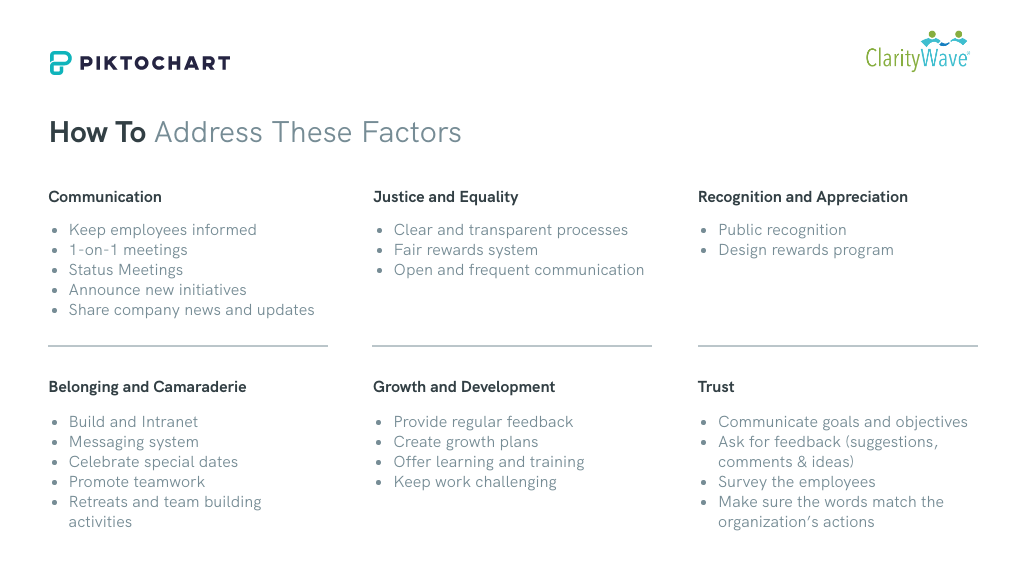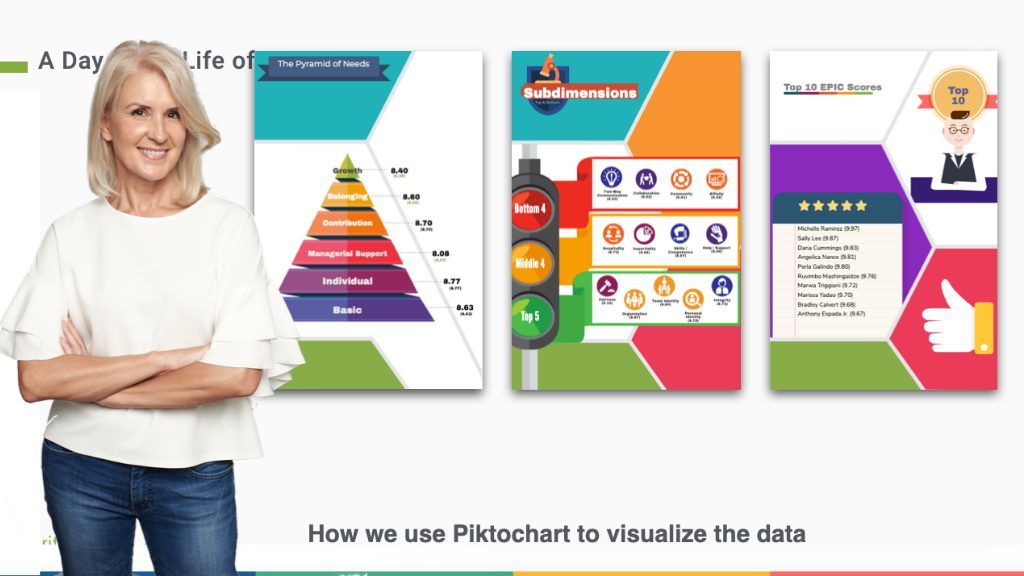Since the pandemic began in early 2020, about one-third of all working Americans are doing so from home. While that is not surprising, what is surprising is that about 42% of us want to continue working from home even after the pandemic is over – according to a national survey by getAbstract.
As employers and HR professionals, how do we keep our employees motivated, engaged, and connected to our organizations and teams during these times of isolation and video conference calls?
We spoke with the Director of Sales at Clarity Wave, Robert Moutal, to discover a secret formula for keeping employees engaged and motivated during remote working.
If you are more the bookworm-learner or you are a bit tired of watching people talking in a webinar, we would love to offer a transcript for you!
Why does employee engagement matter to any organization?
Robert:
There’s a famous Gallop study known as ‘The State of the Workplace’, which outlines ten important things that employee engagement does.
- First of all, it increases profitability. When people are engaged, the whole company starts becoming more profitable.
- It improves the retention rate. People don’t want to leave if they are really engaged in their organization.
- It boosts the happiness of the workplace and that creates a great culture.
- It increases the level of productivity.
- It promotes innovation. People are more innovative when they feel like they are part of the growth of the company.
- It creates more connected employees.
- It encourages better communication.
- It fosters more collaboration.
- It creates commitment with people being committed to the company, which becomes like their tribe and family.
- Finally, it improves recruitment rates and we end up hiring better talent, which is the goal of every company to get the best talent possible.
How does employee engagement relate to motivation?
Robert:
What do you think is more important – to have engaged or motivated employees? This is a trick question because you really want employees who are both engaged and motivated.
The problem with engaged but unmotivated employees is that they typically love the culture, but they are not very productive. They may wear the company’s shirt with pride, attend every event, love all the perks, and embrace the culture well, but it could lead to the extreme that this type of employee is not motivated.
On the other hand, motivated but disengaged employees are driven to achieve their goals. They may get the numbers for sales and attend every training to keep on improving themselves, but they are not engaged. The moment they find a better opportunity somewhere else, they would jump ship.
Hence, we want to have a combination of a high-performing engaged and motivated employees, which is essential for any company.
I wanted to also talk about some studies that have been made in relation to motivation and engagement. Since the 1950s, there have been tonnes of studies and here are some important ones. One of them is the Hierarchy of Needs by Abraham Maslow.

Another theory is the Two-Factor Theory, which consists of two types of motivators.

The next is the Equity Theory, which measures how much someone puts into a company and how much they get back. It’s all about balance.

Finally, another important and more recent one is The 4-Driver Theory of Employee Motivation.

We found in all the studies above that they have six things in common. The first is communication – we want to know what’s happening in a company and we want to be kept updated.
It becomes more important right now that everyone who works remotely receives communication constantly to be aware that the company is growing and developing.
One of the biggest things in our survey is that people don’t believe they are being trained correctly and having their intellectual needs met. As employees, we want to be recognized and appreciated.
Next, we want to be able to trust the company, the leadership, and our coworker. When there is trust, we’re not looking over our shoulders all the time but we can work on our projects without any form of politicking going behind the scenes.
We want to feel like we belong, especially when we spend eight to ten hours at work every day. Hence, we want to feel that we belong to a good work-family. There are some extracurricular activities and not everything has to be about work.
Finally, we want to be treated fairly. An example is a study, The Monkey Fairness Experiment, which shows that our natural desires to be treated fairly.
Here is how we can address the six factors above.

What is the biggest challenge with employee engagement in 2020 – especially with the ongoing global pandemic situation?
Robert:
The biggest challenges have been latent for a long time such as mental health and wellbeing. There are a lot of uncertainties of what’s happening which causes added stress in addition to juggling between work life and home life. Hence, the lines get really blurred all the time.
Another challenge is managing remote work and making sure that our employees are productive and offering them resources to be productive. We cannot be overlooking their shoulders all the time and we need to start trusting in the results rather than their time at work.
Companies are still learning along the way and nobody is getting it right the first time because we’ve never been in this situation at least in the last 100 years.
Lack of agility is also another challenge especially for those who are working in HR. Things move slowly and it takes time for our ideas to permeate through the whole company.
Employee communication is another challenge that organizations have to tackle. The communication department is essential during this time to ensure that employees are receiving updates and constant communication. Include business leaders in providing the updates so they are in front of the people to communicate constantly.
Additionally, there must also be ongoing communication regarding HR policies. HR is changing a lot in this landscape as people adapt to working from home and turning it into a home office.
What are some practical ideas that can be done to improve employee engagement with the rise of remote working?
Robert:
One of the big things is to consider the whole employee. We shouldn’t view our employees as a person whom we see from 9-5. Instead, we should see them as a whole in their family, social life, and how they are adapting to remote work.
It’s important to also get to know our employees on a deeper level and have conversations to ask how they are doing.
Start to also recognize employees for their work and encourage them. Feedback should be a priority to improve employee engagement. Studies have shown that 37% of managers are uncomfortable with giving feedback that may be taken negatively. While managers don’t want to be viewed as the bad cop, it’s important to offer feedback early on and not accumulate it. 72% of employees also state that leaders can be most influential when giving corrective feedback and advice early and when needed.
Another important thing is to give our employees a voice. Make sure that they have an outlet to talk publicly about the company.
It’s also essential to invest in employees for the long term. This whole pandemic is going to pass hopefully soon and the good employees that we nurture throughout this period will be loyal to the organization.
Finally, empower employees to take risks. Empower them to fail fast and quickly, and learn from failures quickly.
How has Clarity Wave helped with driving employee engagement?
For this question, we’d like to encourage you to tune in to the on-demand webinar to have a look at all the cool features of Clarity Wave!
If you’d like to learn more about Clarity Wave, feel free to check them out to find out how to use their tool to make key decisions for keeping your employees motivated and engaged.
How did you further implement Piktochart for communicating the data to make better decisions for employee engagement?
Robert:
We’ve been using Piktochart since the beginning as we were looking for a way to create beautiful visuals. HR would love to dig into the data, but C-level executives mainly to get the important information really quickly.
At Clarity Wave, we use Piktochart to create beautiful visuals in the form of reports. The distribution of the data and results from our tool is turned into a nice visual.


This brief transcript of the webinar offers a glimpse of our conversation with Robert and you can watch the full on-demand webinar to learn more.
Here at Piktochart, we have designed a visual communication tool for Human Resources. If you’d like to find out more about using visual communication just like how Robert is using it for Clarity Wave, take a look here. There are free templates and ideas for HR professionals that you could use to improve employee engagement through visual communication.
This #PiktoWebinar is brought to you by Piktochart with our friends at Clarity Wave.




